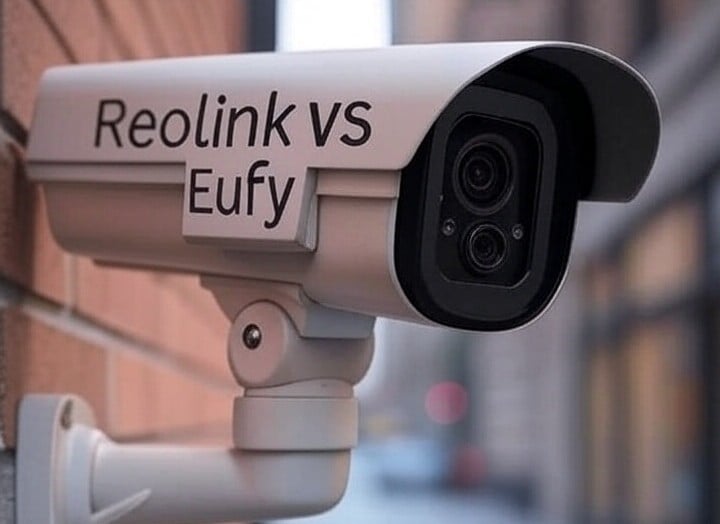Home surveillance has moved from a novelty to a first-line defense for many households. Two names stand out in the debate—Reolink vs Eufy. Both companies sell cameras that promise clear video, smart alerts, and simple setup.
Yet their design choices, storage policies, and long-term costs differ. This guide weighs every major factor, so you can decide which label fits your needs.
Reolink vs Eufy: Brand Overview
Reolink began in 2009. It targets cost-aware buyers who still want advanced options such as 4K, PoE, and solar power. The firm now serves more than two million users worldwide, with frequent releases like the 4K Argus PT Ultra and the battery-driven Altas series.
Eufy is a branch of Anker Innovations, launched in 2016. The line focuses on local AI and fee-free storage through its HomeBase hubs. The current S380 HomeBase (HomeBase 3) ships with 16 GB built-in memory and accepts drives up to 16 TB, giving owners a cloud-free path that appeals to privacy-minded shoppers.
Eufy vs. Reolink: What’s the Difference?
Before diving into point-by-point gaps, note that both firms update hardware every year. Their latest lines share many core traits (wireless use, two-way talk, mobile control), yet they take separate roads on storage, image clarity, smart tools, power, and after-sale costs.
Storage Options
Reolink’s most models hold a microSD card up to 256 GB and can also record to a Reolink NVR or NAS. For example, you can connect your Reolink outdoor security cameras to an NVR located inside your home. If you want off-site backups, Reolink Cloud plans are also available in several countries.
Eufy’s S380 HomeBase stores all clips on-device by default, with 16 GB free space and expansion up to 16 TB. Cloud backup is optional at $2.99 per camera or $9.99 for up to ten cameras each month.
Video Quality
Reolink delivers true 4K (8MP) on different lineups, including the Argus PT Ultra and the new Altas PT Ultra, which pans and tilts while holding 4K clarity.
Eufy reaches 4K on the EufyCam S330, yet many popular sets (SoloCam E40, Indoor Cam 2K) cap at 2K. Night vision favors Eufy in dual-camera doorbells, but Reolink tends to push higher bitrates, which means fewer motion blur lines in bright light.
Smart Features
Reolink adds on-board AI that spots people, cars, and often animals. A 2024 firmware upgrade introduced a privacy mask to ensure user privacy.
Eufy relies on its hub to run on-device face recognition and license-free AI. New floodlights even flash a red beam when the system spots an unknown face.
Power and Installation
Reolink spreads across PoE (one Ethernet wire), battery, and solar. The Altas line can run several days nonstop on a 20,000 mAh battery or continuously with a small solar panel. Wired units like the PoE cameras and systems stay on 24/7 without a battery swap.
Eufy gears most outdoor kits toward battery + solar use, with runtimes up to one year per charge. All cameras link to a central hub, so you must find a spot for that base station and wire it to your router and power socket.
Subscription
Reolink’s entire feature set works without any plan. Cloud adds off-site safety for a small fee. Eufy’s Core AI and local storage are free, but cloud backup costs extra.
Reolink Cameras vs Eufy Cameras: Key Similarities
You already saw how the two brands differ. Now let’s flip the lens and focus on the traits they share, because those common threads matter just as much when you set up a mixed system.
Wireless Options
Each brand sells wire-free models that rely on Wi-Fi. They pair with voice assistants and send push alerts within seconds.
Mobile App Control
Both the Reolink and Eufy Security apps show live views, event clips, and battery stats, and both let you adjust motion zones or talk through the camera speaker.
Smart Home Integration
Alexa and Google Assistant work with nearly every new unit from each label. Reolink also supports RTSP feeds for NAS users, while Eufy adds Apple HomeKit on some new cams.
Reolink vs Arlo vs Eufy: Comparison Table
You can judge specs faster when they sit side by side. The next table lines up the key figures so you can spot price gaps, storage limits, and resolution leaps at a glance.
| Feature | Reolink | Arlo | Eufy |
|---|---|---|---|
| Max resolution | 4K / 8MP | 4K | 4K |
| Local storage | microSD, NVR, NAS | USB drive via SmartHub | HomeBase 3 (16 GB built-in, up to 16 TB) |
| AI detection | People, cars, pets | People, cars, animals | Faces, people, pets |
| Power methods | PoE, battery, solar | Battery, solar, wired | Battery, solar |
| Works offline | Yes (SD/NVR) | Limited | Yes (HomeBase) |
| Third-party links | Alexa, Google, RTSP | Alexa, Google, HomeKit, IFTTT | Alexa, Google, HomeKit* |
| Typical kit price | 4K solo cam ≈ $160 | 2K solo cam ≈ $200 | 4K kit (2 cams + hub) ≈ $400 |
*HomeKit support is limited to selected models.
Reolink and Eufy: Pros and Cons
Raw numbers tell only part of the story. Day-to-day use adds clear wins and real drawbacks, so the next lines weigh each brand’s strong points against its weak spots.
Reolink: Pros and Cons
Pros:
- True 4K even on budget lines.
- Broad choice: PoE, Wi-Fi, 4G, solar.
- Works with third-party NVRs and NAS.
- No forced plan; SD card keeps costs low.
Cons:
- Some models lack HomeKit or Thread compatibility.
- Battery units weigh more than Eufy peers.
Eufy: Pros and Cons
Pros:
- HomeBase 3 handles AI and storage offline, easing data worries.
- Face recognition helps sort families from unknown visitors.
- Battery cameras run long and look discreet.
- Night vision quality leads in the doorbell category.
Cons:
- Doorbell and light products had past privacy lapses, though patches fixed them.
- The hub must sit near the router, adding clutter.
- Some advanced modes need a cloud plan.
- 4K choice is still limited to top-tier sets.
Reolink or Eufy: Which One to Choose?
With features, costs, and trade-offs on the table, it’s time to act. The coming advice links those facts to real-world needs so you can pick with confidence.
Pick Reolink if you want maximum flexibility. Mix PoE for constant power indoors with solar units outside. 4K clarity and RTSP let you grow into a full NVR later.
Pick Eufy if you prefer one box that runs AI and storage on your shelf. Face tags, long battery life, and a clean interface win for users who dislike tech fuss.
Mind data policy. If you handle sensitive footage, Reolink’s SD-based workflow means no hub, no cloud unless you ask. Eufy’s HomeBase encrypts clips, but does keep firmware updated.
Count future costs. Cloud on either brand is optional. If you suspect you will add cameras over time and want remote backups, compare plan tiers before you buy the first kit.
FAQs
Which cameras are better, Eufy or Reolink?
It depends on goals. Reolink provides sharper 4K in more models and wider power choices, while Eufy gives tight hub-based privacy and face sorting. Image detail tips toward Reolink; ease of use tips toward Eufy.
Is Eufy the best security system?
Eufy ranks high for local AI and fee-free storage. Still, it lacks pro monitoring, and past cloud issues hurt trust for some owners. It is best for DIY users who want no monthly bill and can self-check alerts.
Is Reolink a reliable brand?
Yes. The company has shipped cameras since 2009 and keeps a strong reputation for hardware value. Reviews praise clear video and responsive AI. Firmware updates add new features like privacy fences, showing ongoing support.
Conclusion
Choosing between Reolink vs Eufy boils down to power, storage, and personal comfort with cloud ties. Reolink shines with open storage paths, broad model mix, and consistent 4K. Eufy excels at hub-centric privacy, long battery life, and face recognition.
Match the strengths to your own risk level, budget, and home layout. Then share your pick and your experience in the comments—we learn more as each user weighs in.
Caroline is doing her graduation in IT from the University of South California but keens to work as a freelance blogger. She loves to write on the latest information about IoT, technology, and business. She has innovative ideas and shares her experience with her readers.





![‘Frankenstein’ Review – Guillermo del Toro’s Definitive Look At The Nature And Nurture Of Monstrosity [TIFF 2025] ‘Frankenstein’ Review – Guillermo del Toro’s Definitive Look At The Nature And Nurture Of Monstrosity [TIFF 2025]](https://cdn.geekvibesnation.com/wp-media-folder-geek-vibes-nation/wp-content/uploads/2025/10/Frankenstein-175_PF_20240430_20377_R-300x200.jpg)
![‘Wake Up Dead Man: A Knives Out Mystery’ Review – In Rian Johnson We Trust [LFF 2025] ‘Wake Up Dead Man: A Knives Out Mystery’ Review – In Rian Johnson We Trust [LFF 2025]](https://cdn.geekvibesnation.com/wp-media-folder-geek-vibes-nation/wp-content/uploads/2025/10/Wake-Up-Dead-Man-A-Knives-Out-Mystery-300x169.jpg)